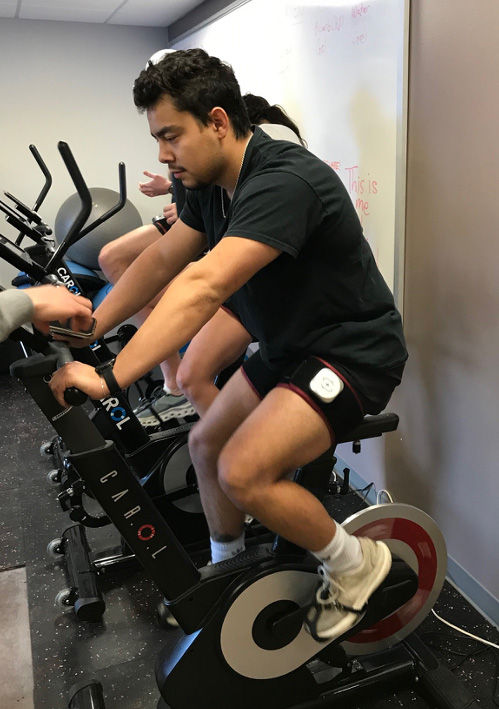
In this series, ACE experts answer your health and exercise questions. From nutrition to youth fitness, you’ll find detailed answers to many of the questions that may come up in your work with clients. If you have questions you’d like to ask our experts, please email us at Christine.Ekeroth@acefitness.org.

The Expert: Lance C. Dalleck, PhD, is a professor of Exercise and Sport Science at Western Colorado University. His research interests include improving exercise performance and health outcomes through evidence-based practice, quantifying the energy expenditure of outdoor and non-traditional types of physical activity, and studying historical perspectives in health, fitness and exercise physiology. Dr. Dalleck is a member of the ACE Scientific Advisory Panel.
Q: What is blood flow restriction training?
A: The practice of exercising with blood flow restriction (a.k.a., BFR) has been around for 40 years. BFR training was popularized in Japan by Yoshiaki Sato and is commonly known as KAATSU training. This type of training involves applying an external occlusion device to the proximal portion of the exercising limbs (e.g., on the upper thing during a cycling workout or the upper during an arm-focused resistance-training session) (Figure 1). The resulting reduction in oxygen delivery and metabolic clearance with the application of BFR essentially mimics the physiological environment at the muscular level during exercise performed at moderate-to-vigorous intensities. Exercising at vigorous intensity requires a significant amount of physical effort and thus increased demands from the cardiovascular system. The advantage of BFR training is that it allows for similar adaptations to occur at lower intensities of cardiorespiratory and muscular training, making it a preferred method of exercise for those with physical limitations or time constraints.
Q: How does blood flow restriction training work?
A: BFR training allows individuals to achieve significant physiological adaptations at much lower intensities and lower volumes when compared to traditional, high-intensity cardiorespiratory and muscular training. For example, BFR training can simulate high-intensity exercise adaptations—greater muscle fiber recruitment, higher levels of metabolite accumulation and better muscle hypertrophy—at loads as low as 20 to 30% of an individual’s one-repetition maximum (1-RM). This is significantly different than the 65 to 85% of 1-RM generally needed to elicit similar muscular hypertrophy and strength gains.
While venous blood flow is restricted, arterial blood flow continues to deliver oxygen- and nutrient-rich blood to the working skeletal muscles. The restriction of venous return causes metabolites and lactate to accumulate in the working muscles. Following are two specific mechanisms that help to explain the improvements in muscular and cardiorespiratory fitness brought about by BFR:
- A hypoxic environment caused by BFR increases muscle-protein synthesis by enhancing the hormonal and cellular stimulation that regular training initiates. This includes elevated levels of growth hormone and increased activation of the mTOR signaling pathway (this is the master switch that tells a cell whether to build, burn or conserve), both of which play key roles in muscle hypertrophy and strength.
- Lactate—traditionally considered a mere byproduct of anaerobic metabolism—is now recognized as a powerful signaling molecule that can drive significant physiological adaptations, including angiogenesis (the formation of new blood vessels) and mitochondrial biogenesis (the formation of new mitochondria). Lactate accumulation stimulates angiogenesis and mitochondrial biogenesis, both key adaptations needed to improve cardiorespiratory fitness (i.e., our body’s ability to deliver and utilize oxygen for energy production).

Figure 1. BFR training involves blood flow restriction to the proximal portion of the exercising limbs by applying an external occlusion device. In the example here, the BFR device is located on the upper thighs during low-intensity, cycle ergometry exercise.
Q: What are some of the risks of blood flow restriction training?
A: BFR training occludes blood flow to the arms or legs while exercising to achieve a higher metabolic stress on the targeted muscles while maintaining a low mechanical stress. The recommended limit for occlusion of an extremity is 20 minutes. This is to ensure the safety of the modality. Extended occlusion of an extremity can cause tissue damage, deep vein thrombosis or impaired blood circulation with reperfusion (when blood flow returns after a period of blockage but remains sluggish or turbulent, causing oxidative stress that can damage tissues). If occlusion is prolonged, permanent damage to the tissue may occur.
Additionally, the recommended arterial occlusion pressure (AOP) during BFR training ranges from 40 to 80% of the individual’s AOP. (Note: AOP is the the minimum cuff pressure needed to completely stop arterial blood flow distal to the cuff.) As such, it is critical for exercise professionals and clients alike to select BFR devices that provide valid, personalized AOP values. Excessive duration or pressure is also extremely painful and unpleasant for clients, reducing the likelihood of long-term adherence. In summary, when it comes to BFR training, more is not better. Be sure to monitor both duration and intensity carefully.
Q: How can I integrate BFR training into my client’s exercise programming?
A: The FITT formula—frequency, intensity, time (duration) and type of exercise—can be applied to BFR training. The following recommendations are based on published guidelines and research from the High Altitude Performance Laboratory at Western Colorado University.
- Frequency: Research suggests that two to three sessions per week of BFR training are effective for improving various performance markers.
- Intensity: Intensity is controlled by a combination of the BFR occlusion pressure and the intensity of cardiorespiratory and muscular training performed in conjunction with BFR.
- The recommended AOP during BFR training ranges from 40 to 80% of individual AOP.
- Cardiorespiratory training intensity with BFR should be less than 50% of a client’s maximal oxygen uptake (VO2max).
- Muscular training intensity with BFR should be 20 to 30% of an individual’s 1-RM.
- Time: Total time of BFR training per session should be between 10 and 20 minutes (cardiorespiratory and/or muscular training).
- Type: Choose commercially available BFR devices that provide valid, individualized AOP values for both effectiveness and safety reasons.
Several other considerations merit discussion. Because BFR training should be performed at low intensity, incorporating it into the warm-up phase of either cardio or strength workouts helps ensure appropriate intensity. Progress BFR training gradually during the first month: start with one session per week, move to two sessions, and then advance to the target three sessions per week. Similarly, while the eventual upper limit is 20 minutes per session, build toward that duration over the same timeframe.
Finally, BFR should be periodized just like any other modality. Six- to eight-week blocks of BFR training can be interspersed with other specialized types of training, such as cold water or hot water immersion. In general, the base phase of periodization is an ideal time to integrate BFR training.
Q: What are some of the benefits one can expect from blood flow restriction training?
A: BFR training offers numerous benefits, including improved muscle hypertrophy and enhanced cardiorespiratory and muscular fitness levels. These benefits can be achieved with the recommended FITT of BFR training highlighted earlier.
In fact, at our lab Western Colorado University we just completed a BFR training project that consisted of participants completing cardiorespiratory exercise with BFR. The BFR training lasted six weeks and included three BFR sessions per week for 20 minutes per session at 50% AOP. These BFR sessions were integrated into the warm-up portion of workouts with participants completing cardiorespiratory exercise on a bike at 50 to 60% of their first ventilatory threshold (VT1). At baseline and after six weeks of BFR training, participants completed VO2max and push-up tests to measure cardiorespiratory fitness and muscular fitness levels. The improvements in VO2max and push-up test performance after six weeks of BFR training were 10% and 20%, respectively. Impressively, every participant in the project improved their VO2max performance (see Figure 2). In summary, these benefits from BFR training were achieved with a short program of six weeks and with a total of one hour of BFR each week, which was implemented into the warm-up portion of workouts. The takeaway message for exercise professionals and clients is that BFR training can be effective with fairly short interventions (i.e., six weeks) and modest one-hour durations/week of BFR.

Figure 2. Changes in maximal oxygen uptake values (cardiorespiratory fitness) after six weeks of BFR training.
Blood-flow restriction can be a powerful adjunct to traditional training, but its efficacy hinges on precise application and vigilant monitoring. Because safe, individualized pressures and time limits are non-negotiable—and because client tolerance can vary widely—exercise professionals should approach BFR with the same respect they give any advanced modality: start conservatively, document responses and adjust only when objective data support progression. Equally important, stay within your scope of practice by pursuing reputable courses, manufacturer trainings or peer-reviewed resources before introducing BFR to clients. By coupling caution with continuing education, you’ll maximize benefits, minimize risk and uphold the professional standards your clients expect.





 by
by 





